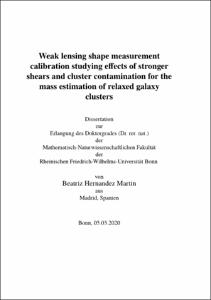Hernandez Martin, Beatriz: Weak lensing shape measurement calibration studying effects of stronger shears and cluster contamination for the mass estimation of relaxed galaxyclusters. - Bonn, 2020. - Dissertation, Rheinische Friedrich-Wilhelms-Universität Bonn.
Online-Ausgabe in bonndoc: https://nbn-resolving.org/urn:nbn:de:hbz:5-59522
Online-Ausgabe in bonndoc: https://nbn-resolving.org/urn:nbn:de:hbz:5-59522
@phdthesis{handle:20.500.11811/8622,
urn: https://nbn-resolving.org/urn:nbn:de:hbz:5-59522,
author = {{Beatriz Hernandez Martin}},
title = {Weak lensing shape measurement calibration studying effects of stronger shears and cluster contamination for the mass estimation of relaxed galaxyclusters},
school = {Rheinische Friedrich-Wilhelms-Universität Bonn},
year = 2020,
month = sep,
note = {Weak lensing measurements suffer from well-known shear estimation biases, which can be partially corrected for with the use of image simulations. In this work we present an analysis of simulated images that mimick observations of high-redshift galaxy clusters as seen by different telescopes, including cluster specific issues such as non-weak shear and increased blending. Our synthetic galaxies have been generated to have similar observed properties as the background-selected source samples studied in the real images. The study of the bias coming from isolated galaxies, as well as the inclusion of the effect of neighbours and selection bias provide a round analysis of the different effects. The impact of cluster members was found to be negligible for high-redshift (I > 0.7) clusters, whereas shear measurements can be affected at the 1% level for lower redshift clusters given their brighter member galaxies. The presence of faint neighbours and selection bias, however, is shown to be important to obtain robust bias estimates. Simulations were created mimicking the galaxy and telescope properties of cluster images from the Hubble Space Telescope Advance Camera for Surveys, the HAWK-I camera in the Very Large Telescope and the Hyper Suprime-Cam in the Subaru telescope. New corrections dependent on the signal-to-noise ratio are obtained for all of them, leading to a residual multiplicative bias below 1%, and an uncertainty level of 1 - 5%. The study of the systematic constraints for this bias is done by carefully analysing the impact of the different parameters used to create our simulations in the bias estimation. As an application we use the results obtained for the HST/ACS-like simulations for a refined analysis of three highly relaxed clusters from the SPT-SZ survey, where we now include measurements down to the cluster core (A > 200 kpc) as enabled by our work. Compared to previously employed scales (A > 500 kpc) this tightens the cluster mass constraints by a factor 1.38 on average.},
url = {https://hdl.handle.net/20.500.11811/8622}
}
urn: https://nbn-resolving.org/urn:nbn:de:hbz:5-59522,
author = {{Beatriz Hernandez Martin}},
title = {Weak lensing shape measurement calibration studying effects of stronger shears and cluster contamination for the mass estimation of relaxed galaxyclusters},
school = {Rheinische Friedrich-Wilhelms-Universität Bonn},
year = 2020,
month = sep,
note = {Weak lensing measurements suffer from well-known shear estimation biases, which can be partially corrected for with the use of image simulations. In this work we present an analysis of simulated images that mimick observations of high-redshift galaxy clusters as seen by different telescopes, including cluster specific issues such as non-weak shear and increased blending. Our synthetic galaxies have been generated to have similar observed properties as the background-selected source samples studied in the real images. The study of the bias coming from isolated galaxies, as well as the inclusion of the effect of neighbours and selection bias provide a round analysis of the different effects. The impact of cluster members was found to be negligible for high-redshift (I > 0.7) clusters, whereas shear measurements can be affected at the 1% level for lower redshift clusters given their brighter member galaxies. The presence of faint neighbours and selection bias, however, is shown to be important to obtain robust bias estimates. Simulations were created mimicking the galaxy and telescope properties of cluster images from the Hubble Space Telescope Advance Camera for Surveys, the HAWK-I camera in the Very Large Telescope and the Hyper Suprime-Cam in the Subaru telescope. New corrections dependent on the signal-to-noise ratio are obtained for all of them, leading to a residual multiplicative bias below 1%, and an uncertainty level of 1 - 5%. The study of the systematic constraints for this bias is done by carefully analysing the impact of the different parameters used to create our simulations in the bias estimation. As an application we use the results obtained for the HST/ACS-like simulations for a refined analysis of three highly relaxed clusters from the SPT-SZ survey, where we now include measurements down to the cluster core (A > 200 kpc) as enabled by our work. Compared to previously employed scales (A > 500 kpc) this tightens the cluster mass constraints by a factor 1.38 on average.},
url = {https://hdl.handle.net/20.500.11811/8622}
}






